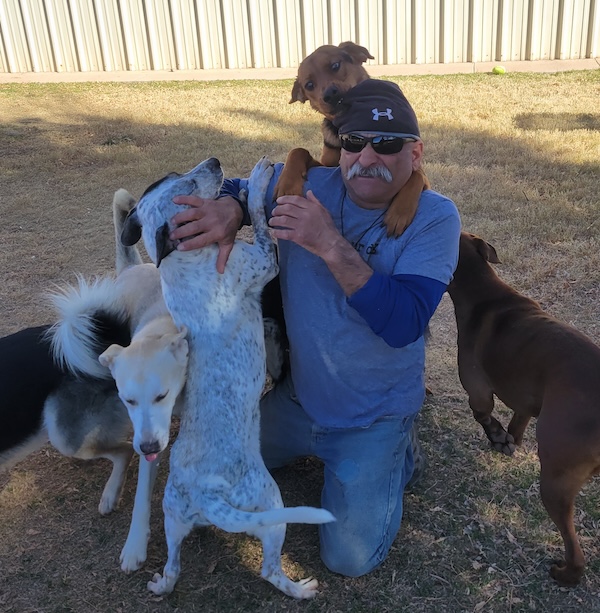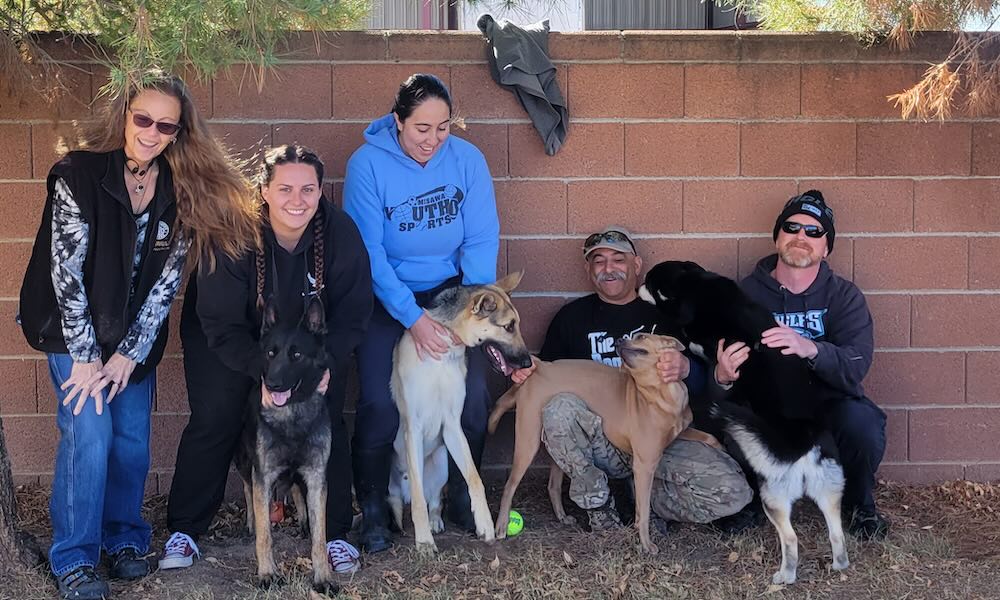After seeing an epidemic of dog overpopulation in his southern New Mexico county, Anthony “Buddy” Gurnari took it upon himself to be the difference in dogs’ lives.
What started as taking shelter dogs for daily walks quickly turned into a full non-profit operation.
Now, Buddy is helping dozens of dogs with medical treatments, encouraging adoption throughout the community, and doing what he can to make dogs’ lives “a little bit better.”

Image via Dogbreath Express
A Q&A with Anthony “Buddy” Gurnari
What was the spark that began DogBreath Express?
Dogbreath Express began in February of 2015 after I saw a stray dog standing along the shoulder of the highway. When I tried to approach him, he would run to the yard of an abandoned mobile home. When I would walk away, he’d follow me, but then return to the yard.
My ex-wife and I were able to get him in my truck and we took him to the county animal control with the understanding that we would take him if he wasn’t claimed in a week.
While I was at the shelter, I asked if I could start taking the shelter dogs for walks. After getting the go-ahead from the shelter manager, I have been going to the shelter almost every day since. “Mugsy” is living with my ex-wife.
At that time, Otero County had a very high euthanasia rate. One dog stood out the most — I named her Cleopatra because of the liner around her eyes. She was the type of dog that when she looked at you, you’d swear she was looking at your soul. A few days later, Cleopatra and 10 other dogs were euthanized before I got to the shelter.
That day, I knew I had to do something, so I searched the web for no-kill rescues in New Mexico and surrounding states. With help from a couple of friends, I became a 501(c)(3) non-profit. All money that is donated goes directly to helping the dogs with transports, spay/neuters, medical treatment, and anything we can find to make their lives a little better.
How have you seen Dogbreath Express impact the community around you?
I believe Dogbreath Express has had a profound impact on the community.
We post the available cats and dogs at least weekly, as well as the new animals that come in. We also post stories, photos, and videos of the dogs almost daily.
Our low-cost spay/neuter program has been a huge success since we started it around six months ago, although we still have a ways to go in getting many more people on board.
We have a good following on our Facebook page, and I think that has bonded the animal lovers in our county.
This was very helpful when I was asked to speak at a combined meeting of the Otero County Commission, the City of Alamogordo Commission, and the mayor. The goal of the two municipalities was to combine the shelters and resources to better help the homeless dog population. It has been a huge help with most of our city and county politicians working towards that effort. Even the county manager has personally gotten involved by writing a curriculum where the schools can educate the children on being responsible pet owners.
Do you see a common thread with the amount of dogs being surrendered recently?
There are common threads with the number of animals surrendered.
The first is the proximity to Holloman Air Force Base. We see a lot of surrenders because of deployments and changes in assignments. We explain to the owner that the military has provided options for people to keep their pets. The military has a couple of programs for fostering pets of deployed service members and Congress has allocated funds for traveling with pets while on a military move, including overseas’ tours. Still, they keep coming in.
COVID-19 does seem to have impacted not only this shelter, but most of the out-of-state no-kill shelters we were taking our dogs and cats to. They are overwhelmed and not taking from outside their communities. Every weekend, we email letters to more rescues in other states, but the response is the same: no room.
Southern New Mexico is also a very strong owner’s rights area. Dogs are considered property and a lot of people don’t want to be told how to take care of their property, regardless of the animal’s welfare. The local pet animal ordinances in most of New Mexico are very lax for this reason.
What does your day-to-day work look like with these dogs?
My day at the shelter typically starts with greeting every dog by name and sneaking them treats if the staff has already finished with the feeding.
If a new dog moved over to the adoption side of the building from the intake side, we’ll give the dog time alone in the play yard to get used to the smells and environment. When the new dog seems to be relaxed, we’ll behavior test with one of our calmer dogs.
We have had a lot of success with socializing the dogs and we try to keep the play groups with the same sex or with a fixed member of the opposite sex. This way, we can double up the kennels without unwanted pregnancies.
The way we have worked with our no-kill rescue partners is that we’ll send them a list of dogs or they select from our Facebook post and we’ll provide them with more information about the dog. Once a selection is made, we schedule a veterinarian appointment for the beginning of the following week. This is for their rabies vaccination and health certificate. We try to transport at the end of that week.
What do you want people to know about DogBreath Express?
The most important job I volunteer for at the shelter is the one I wish no one should ever have to do — assist during euthanizing. When the shelter is beyond capacity and there is absolutely no room for dogs on intake, we — the shelter staff and I — must make the decision of who we must let go.
When the time comes, I take each dog, one at a time, to the play yard and spend time with them. After, the shelter manager administers the sedative, I hold the dog — usually with their head on my lap — while the lethal injection is given. The important thing is to put on a straight face as I take out someone else. Their last moments should be happy and feeling loved.
Not all rescue work involves sending dogs and cats to no-kill shelters. This is our goal, but just as important is giving each of these dogs the best life they can have while they are at the shelter. For some of these animals, it may be their best life.
I believe working with a shelter staff that cares, having a small team of dedicated volunteers, and the show of support from the community with donations of cash, toys, treats, and blankets — as well as positive posts and comments on our Facebook page — has made a big difference in helping the stray, abandoned, and abused dogs and cats in our community.








